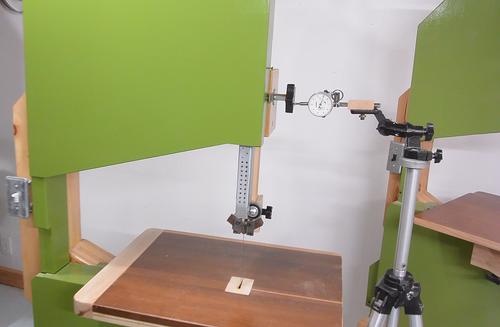 After having tested my big bandsaw with big
stuff like logs, I switched it back to a 1/4" blade
and used it for this video.
Cutting small stuff with it, the bandsaw's vibrations became
more noticeable. So I figured I should try to improve on that.
After having tested my big bandsaw with big
stuff like logs, I switched it back to a 1/4" blade
and used it for this video.
Cutting small stuff with it, the bandsaw's vibrations became
more noticeable. So I figured I should try to improve on that.
 After having tested my big bandsaw with big
stuff like logs, I switched it back to a 1/4" blade
and used it for this video.
Cutting small stuff with it, the bandsaw's vibrations became
more noticeable. So I figured I should try to improve on that.
After having tested my big bandsaw with big
stuff like logs, I switched it back to a 1/4" blade
and used it for this video.
Cutting small stuff with it, the bandsaw's vibrations became
more noticeable. So I figured I should try to improve on that.
On my saw, I didn't notice any significant change in pitch, so it wasn't that.
For a test, I put some box board shims behind part of the tire of the saw. The change in pitch was just noticeable. The box board was 0.3 mm (0.0012") thick. Realistically, this amount of variation is high, but might still be within reason. It also depends on the size of the saw, for a 9" bandsaw, 0.3 mm would be far too much.
On this one, the motor is still not very rigidly mounted, because I will probably still change motors on it. I noticed the motor was moving a tiny amount, so jammed some pieces of wood against it to stop it from moving. But that didn't make a noticeable difference, so motor shaking wasn't the cause either.
So I put some roller skate bearings on a shaft and put the wheels onto those. The small roller skate bearings (22 mm diameter) roll inside the holes of the main bearings (25.4 mm diameter), so the wheels could turn more easily.
I found the wheels were a bit unbalanced, and screwed in some screws to add weight on the light side. But overall, it was just a few grams worth of weight that I added. And this again only made a minor difference in vibrations. So whatever amount of unbalance was left, that probably didn't account for the shaking.
I only had the saw on a dolly made with wimpy office chair casters. But those
office chair casters are designed to take my weight, and the saw doesn't weigh much more
than I do. My next experiment was to put pieces of wood under the stand so it rested more
rigidly against the floor. This made a dramatic difference, but for the worse!
With the more rigid support, the saw's resonant rocking back and forth frequency
became higher, much closer to the speed of the wheels. So that was a bad idea!
I had encountered this before. When I took my 14" bandsaw to a friend
to film the bandsaw vs. CNC video, I forgot to bring the stand, so
to get it at the right height we put it on a workmate with the lower legs folded in.
This was a rather wobbly base, but, surprisingly the bandsaw was much steadier on this
than on a better stand.
So I put this saw back on the wimpy office chair casters. And testing it, I was able to balance a faceted 5 cent coin on the table (though only after starting the saw), so maybe it's good enough.
I may at some point add a hook on the back to securely hold the 10 lb weight. But for now I figured this is good enough.
But I had already improved the balance of the lower wheel by quite a lot, without making much of a difference, so it probably wasn't that, and reducing the motor shaking didn't help either. But putting my fingers on the V-belt while turning it slowly, I noticed it ran quite unevenly, even though the big pulley didn't have much in the way of "bumps" on it. At any rate, running the saw without a blade helps narrow down the source of vibrations, and I should have tested that earlier.
My thinking is, if you have a choice between a 1750 RPM motor or a 3500 RPM motor, pick the slower motor and use a larger pulley. Your saw will be quieter, less vibrations, and the V-belt will be more efficient and last longer from not having to bend as tightly.